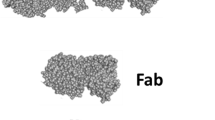Abstract
MFECP1 is a glycosylated recombinant fusion protein composed of MFE-23, a high-affinity anti-carcinoembryonic antigen (CEA) single chain Fv (scFv), fused to the enzyme carboxypeptidase G2 (CPG2), and has been constructed for use in antibody-directed enzyme pro-drug therapy (ADEPT). Radiolabelling of glycosylated MFECP1 with technetium-99m was developed for the purpose of determining tumour localisation of MFECP1 in a phase I ADEPT clinical study. The method used was 99mTc-carbonyl [99mTc(H2O)3(CO)3]+ (abbreviated to TcCO) mediated labelling of 99mTc to the hexahistidine (His) tag of MFECP1. MFECP1 fusion protein was labelled with TcCO under a variety of conditions, and this was shown to be a relatively simple and robust method. Tissue biodistribution was assessed in a CEA-expressing LS174T (human colon carcinoma) nude mouse xenograft model. Tissues were taken at 1, 4 and 6 h for assessment of distribution of radioactivity and for measurement of CPG2 enzyme levels. The amount of radioactivity retained by the tumour proved to be an accurate estimation of actual measured enzyme activity, indicating that this radiolabelling method does not appear to damage the antibody–antigen binding or the enzyme activity of MFECP1. However, correlation between CPG2 enzyme activity and measured radioactivity in liver, spleen and kidney was poor, indicating retention of radioactivity in non-tumour sites but loss of enzyme activity. The high retention of technetium radioisotope in normal tissues may limit the clinical applicability of this radiolabelling method for MFECP1; however, these results suggest that this technique does have applicability for measuring the biodistribution of His-tagged recombinant proteins.




Similar content being viewed by others
References
Bagshawe KD. Antibody directed enzymes revive anti-cancer prodrugs concept. Br J Cancer 1987; 56:531–532.
Bagshawe KD. Towards generating cytotoxic agents at cancer sites. Br J Cancer 1989; 60:275–281.
Bagshawe KD. Antibody-directed enzyme prodrug therapy (ADEPT) J Controlled Release 1994; 28:187–193.
Napier M, Sharma S, Springer C, Bagshawe K, Green A, Johnson C, Martin J, Stribbling S, Cushen N, O’Malley D, Begent R. Antibody-directed enzyme prodrug therapy (ADEPT): efficacy and mechanism of action in colorectal cancer. Clin Cancer Res 2000; 6:765–772.
Bagshawe K, Sharma S, Springer C, Antoniw P. Antibody directed enzyme prodrug therapy: a pilot scale clinical trial. Tumour Targeting 1995; 1:17–30.
Chester KA, Begent RH, Robson L, Keep P, Pedley BR, Boden JA, Boxer G, Green A, Winter G, Cochet O, Hawkins RE. Phage libraries for generation of clinically useful antibodies. Lancet 1994; 343:455–456.
Michael NP, Chester KA, Melton RG, Robson L., Nicholas W, Boden JA, Pedley RB, Begent RHJ, Sherwood HJ, Minton NP. In vitro and in vivo characterisation of a recombinant carboxypeptidase G2::anti-CEA scFV fusion protein. Immunotechnology 1996; 2:47–57.
Bhatia J, Sharma SK, Chester KA, Pedley RB, Boden RW, Read DA, Boxer GM, Michael NP, Begent RH. Catalytic activity of an in vivo tumor targeted anti-CEA scFv::carboxypeptidase G2 fusion protein. Int J Cancer 2000; 85:571–577.
Chester KA, Bhatia J, Boxer G, Cooke SP, Flynn AA, Huhalov A, Mayer A, Pedley RB, Robson L, Sharma SK, Spencer DIR, Begent RHJ. Clinical applications of phage-derived sFvs and sFv fusion proteins. Dis Markers 2000; 16:53–62.
Sharma SK, Pedley RB, Bhatia J, Minton NP, Chester KA, Begent RHJ. In vivo characteristics of an engineered fusion protein for ADEPT. Br J Cancer 2000; 83 (S1):71a.
Alberto R, Schibli R, Egli A, Schibiger A. A novel organometallic aqua complex of technetium for the labeling of biomolecules: synthesis of [99mTc(OH2)3(CO)3]+ from [99mTcO4]− in aqueous solution and its reaction with a bifunctional ligand. J Am Chem Soc 1998; 120:7987–7988.
Waibel R, Alberto R, Willuda J, Finnern R, Schibli R, Stichelberger A, Egli A, Abram U, Mach J, Pluckthun A, Shubiger P. Stable one-step technetium-99m labeling of His-tagged recombinant proteins with a novel Tc(I)-carbonyl complex. Nature Biotechnol 1999; 17:897–901.
Waibel R, Stichelberger A, Alberto R, Schibli R, Novak I, Schubiger PA. Site-directed labelling of single chain antibodies with Tc-99m and Re-188. Proceedings of 16th International Conference on Advances in the Applications of Monoclonal Antibodies in Clinical Oncology, 1999.
Blakey DC, Burke PJ, Davies DH, Dowell RI, East SJ, Eckersley KP, Fitton JE, McDaid J, Melton RG, Niculescu-Duvaz IA, Pinder PE, Sharma SK, Wright AF, Springer CJ. ZD2767, an improved system for antibody-directed enzyme prodrug therapy that results in tumor regressions in colorectal tumor xenografts. Cancer Res 1996; 56:3287–3292.
Mease RC, Lambert C. Newer methods of labeling diagnostic agents with Tc-99m. Semin Nucl Med 2001; 16:278–285.
Casey JL, Keep PA, Chester KA, Robson L, Hawkins RE, Begent RH. Purification of bacterially expressed single chain Fv antibodies for clinical applications using metal chelate chromatography. J Immunol Methods 1995; 179:105–116.
Verhaar MJ, Keep PA, Hawkins RE, Robson L, Casey JL, Pedley RB, Boden JA, Begent RHJ, Chester KA. Technetium-99m radiolabelling using a phage-derived single-chain Fv with a C-terminal cysteine. J Nucl Med 1996; 37:868–872.
Stalteri MA, Bansal S, Hider R, Mather SJ. Comparison of the stability of technetium-labeled peptides to challenge with cysteine. Bioconjugate Chem 1999; 10:130–136.
Pietersz GA, Patrick MR, Chester KA. Preclinical characterization and in vivo imaging studies of an engineered recombinant technetium-99m-labeled metallothionein-containing anti-carcinoembryonic antigen single chain antibody. J Nucl Med 1998; 39:47–56.
Francis RJ, Sharma SK, Springer C, Green AJ, Hope-Stone LD, Sena L, Martin J, Adamson KL, A Robbins, L Gumbrell, O’Malley D, Tsiompanou E, Shahbakhti H, Webley S, Hochhauser D, Hilson AJ, D Blakey, Begent RHJ. A phase I trial of antibody directed enzyme prodrug therapy (ADEPT) in patients with advanced colorectal carcinoma or other CEA producing tumours. Br J Cancer 2002; 87:600–607.
Author information
Authors and Affiliations
Corresponding author
Rights and permissions
About this article
Cite this article
Francis, R.J., Mather, S.J., Chester, K. et al. Radiolabelling of glycosylated MFE-23::CPG2 fusion protein (MFECP1) with 99mTc for quantitation of tumour antibody-enzyme localisation in antibody-directed enzyme pro-drug therapy (ADEPT). Eur J Nucl Med Mol Imaging 31, 1090–1096 (2004). https://doi.org/10.1007/s00259-004-1474-4
Received:
Accepted:
Published:
Issue Date:
DOI: https://doi.org/10.1007/s00259-004-1474-4




